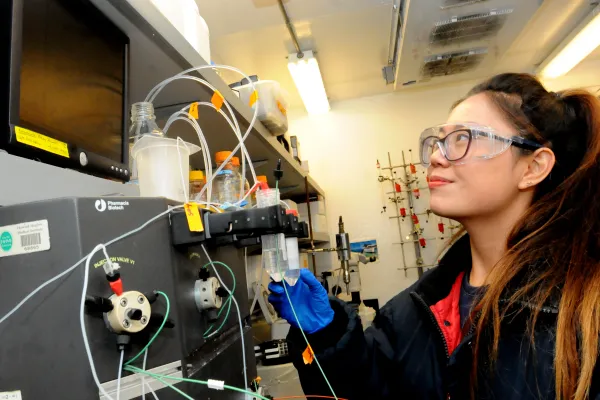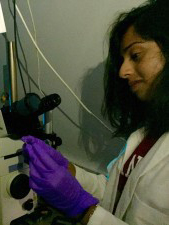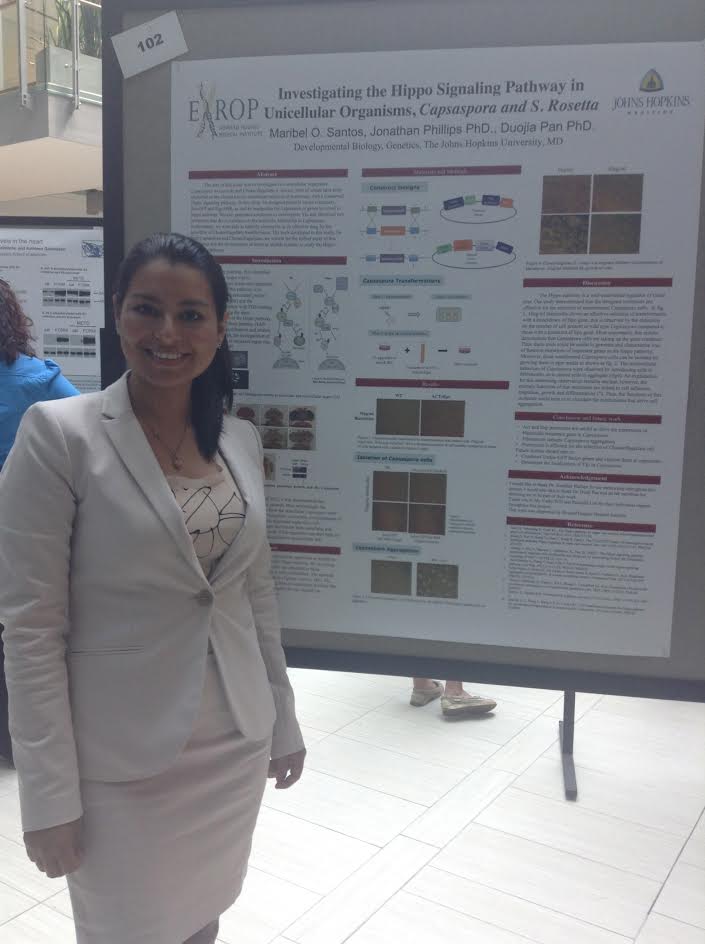What We Did This Summer: Smithies Lead in Scientific Research
Research & Inquiry

Published September 16, 2015
Among the things that set science education at Smith ahead of many other liberal arts colleges is Smith’s commitment to hands-on research—both on and off campus.
This year, Smith students led the nation in securing competitive grants through the Exceptional Research Opportunities Program (EXROP) for summer projects in science labs around the nation.
The program, sponsored by the Howard Hughes Medical Institute, is designed to promote a diverse and highly trained workforce in the sciences by supporting undergraduates from groups traditionally underrepresented in STEM.
Through the program, Smith faculty and staff nominate juniors and seniors for the grants, which support scientific research off campus for the summer. Each grant carries a $4,500 stipend that covers living, travel and housing expenses.
With three students awarded EXROP grants this year—and three returning EXROP students invited for a second summer—Smith joins only a handful of schools with more than two participants in the program. (The others are Yale University with three and the University of California Los Angeles with five).
That means Smith had more students participating in EXROP this summer than any other college or university in the country.
Smith psychology professor Patricia DiBartolo, faculty director of the sciences, said student research is a key component of STEM education at Smith.
“The fact that all three of our EXROP awardees from last year were invited back to conduct research with mentors for a second summer attests to the regard given our students as scientists,” DiBartolo said. “Their successes are a testament to the high quality mentoring and science education Smith offers its students.”
To find out what made their summer research projects exceptional, we asked EXROP students to reflect on what they learned in their respective laboratories. Here’s what they had to say, starting with the three newest EXROP participants (host educational institutions are listed in parentheses).
Melody Cao ’16 (University of California, Berkeley)

“EXROP was an opportunity for me to undertake research this summer as an Amgen Scholar in the field of structural biology. We spent the summer working on crystallization and x-ray crystallography of human alpha CaMKII, a protein that is a leading candidate for understanding the molecular basis of human memory. I had the chance to explore the field of biophysics, which was unfamiliar to me. From the beginning stages of reading the literature to experimenting in the lab to going to meetings and presentations—and finally, getting my own results—I experienced a research lab beyond any textbook. The project I worked on is pushing right on the boundary of our current understanding of human memory storage. We made quite a discovery this summer and plan to get a paper out by the end of the year. We will also be submitting our solved structure to the Worldwide Protein Data Bank so it can be readily available to the global scientific community. This coming semester, I’ll mainly be working on my senior thesis and graduate school applications. With this amazing experience, Berkeley is definitely one of my top choices.” (Photo by Peg Skorpinski.)
Eirini Tsekitsidou ’16 (Stanford University)

“My research took place at the Tim Stearns lab at Stanford. The lab studies cilia, centrosomes and the cellular cycle, and my goal was to investigate how a line of human cells responds when cells lose their centrosome (a region near the nucleus of a cell). We know that centrosomes are crucial organelles for the cell, and their dysfunction can lead to a number of diseases, including cancer. The best thing about working on the project was being able to talk about it with other people who share the same passion and enthusiasm. Whether it was people in the lab or my peers from the Stanford summer program, everyone was willing to help me. I was the only undergraduate student in the lab, and it was challenging to keep up with my labmates’ levels of skill and knowledge. A key lesson I’ve learned is that work on any research project takes patience and flexibility. A good scientist must be prepared to face unfamiliar or even disappointing situations and be able to bounce back and move forward. I’ve also learned that research is more rewarding when it is done through discussion instead of competition. This fall at Smith, I will be returning to work in the Steve Williams lab and will be applying to graduate school.”
Naina Zaman ’16 (Stanford University)

“I’ve been working on furthering the field of cell-imprinted polymers to form artificial receptors for microorganisms, such as bacteria, on polymer surfaces. The polymers are synthesized using sol-gel chemistry, a method for producing solids from small molecules. They are then imprinted with bacteria to form cavities that can be used to selectively capture the imprinted bacteria in solution, such as in a blood draw. There are many uses for this new technology, including the detection of pathogens causing infectious diseases such as tuberculosis, or food pathogens such as E.coli. The most exciting aspect of my project was its interdisciplinary nature. In high school and college, we are often taught that sciences fall into distinct categories. Working at Stanford has shown me how the divide between the core sciences is decreasing and the importance of collaboration. This summer has inspired me to pursue a Ph.D. in chemistry, doing research on physical chemistry of biological organisms or developing novel pharmaceuticals for fatal diseases. I would like to eventually work for the government as a research and development manager while encouraging other women to work in STEM, since we are still very underrepresented in the field.”
Metasebia Aberra ’15 (University of Michigan)
“My research this summer was studying a bacterial periplasmic protein called Spy, which is a “chaperone protein” in bacteria, serving as a molecular aid for proteins assuming their shape. I studied how Spy can prevent the aggregation of a protein called Tau—known to be the primary cause of Alzheimer’s disease. The best thing about working on my project was working with a fellow intern and my supervisor. I enjoyed collaborating with them, brainstorming ideas, designing projects and analyzing results, which accelerated my learning. I was excited about coming to work because my research was interesting and I had fun with co-workers in the lab. The most challenging thing was having to conduct a job search along with my research. That was an emotionally taxing process that involved multiple interviews. The key lesson I learned from my summer experience is the importance of making deep personal connections wherever I go. It is key to treat colleagues with the utmost respect, as they will be the people I will reach out to in the future. I will be starting a job this fall at a start-up cancer institute called Perthera, Inc., in Virginia.”
Taleen Dilanyan ’16 (University of Utah)
“My research has focused on using molecular biology to find toxins from the venom of marine snails known as Cone Snails. These toxins are relevant because they target specific channels in cell membranes, and studying them can improve what we know about ion channels (pore-forming membrane proteins) and could possibly help with medical applications. One of the best—and sometimes most difficult—parts of my project was that it was all my own. No one else in the lab was doing work on the same project, and the particular toxins I was working with have not been published about. So it felt unique. The project also helped me realize which areas of my research I’m most interested in pursuing in graduate school. The project was hard work and required constant analytical thinking, not just following procedures. But that was also the most beneficial part of my summer because it taught me skills of problem solving and project design. The need for cooperation and good working relationships was one of the most important lessons I learned. I am preparing to apply to graduate school this fall to pursue a Ph.D. in either peptide or medicinal chemistry.”
Maribel Santos ’15 (Johns Hopkins University)

“I have been working in the Department of Molecular Biology and Genetics. The main focus of the lab is to investigate developmental pathways that control organ growth in normal development and in organisms with cancer. Specifically, I have been investigating proteins involved in a signaling pathway that is critical to controlling organ size. The best thing about the project is that I get to work in something completely new. We are learning as we go, creating our own path. We get to design new protocols from scratch, which means I’m being exposed to a number of different genetic lab techniques and am part of the problem-solving process. The most challenging part of my research is also the most exciting part. Because we are trying to establish new genetic tools, we have to be focused, creative and have lots of patience. I’ve learned to be bold and not to be afraid of making mistakes. For my next step, I am currently applying to medical school. As a medical professional, I’d like to be able to use basic research knowledge to address clinical issues.”
Melody Cao '16, shown here in a lab at the University of California, Berkeley, was one of six Smithies participating in this summer's Exceptional Research Opportunities Program. Photo by Peg Skorpinski.